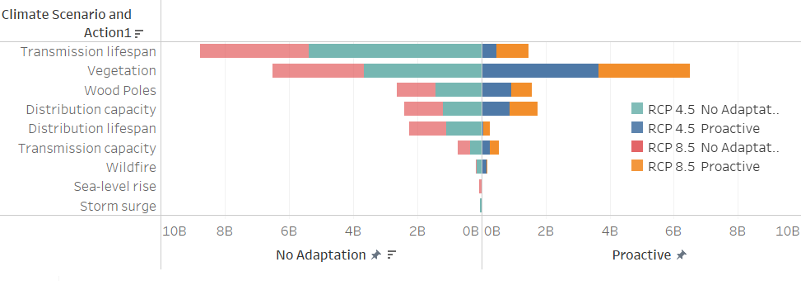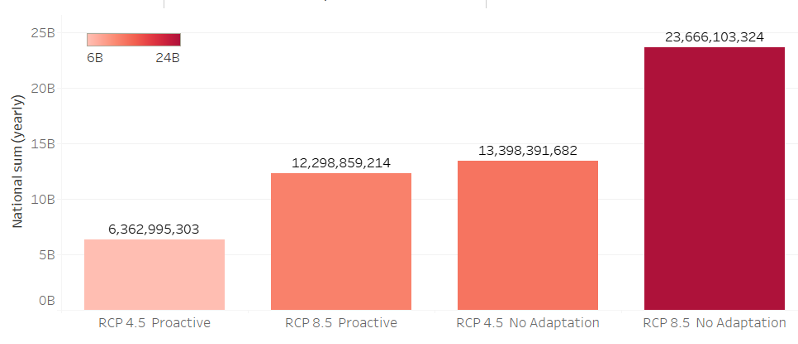
Authors: Shagun Sengupta & Dr. Jason Shafer
Electricity is one of the most essential commodities of the modern world. The greatest invention of all time1 faces the greatest threat of all time2 - climate change. The power grid system that brings electricity to your home, is a complex, yet fragile system that is exposed to physical damage due to extreme weather conditions and increasing temperatures.
The electricity grid in the continental US (CONUS) is non-homogeneous, but mostly with overhead lines, and has three major factors that determines it's resilience:
1. The health of the asset - this is the raw material that was used to make the poles, wood, concrete, iron, etc., and the age of the asset.
2. Weather & climate - the weather and climate determines the speed of wear and tear of the asset. It is also what determines the raw material that is used for construction. Extreme weather hazards can also cause physical damage.
3. Tree cover - the presence of trees near electric lines pose a threat due to physical damage, for example, a tree falls on the grid wires and/or poles. This threat is more pronounced in extreme weather such as hurricanes, thunderstorms, floods, and wildfires.
The maintenance and upkeep of the system is a recurring cost that is only increasing with the effect of climate change. Scientists are continuing to develop better global climate models (GCMs) taking into account Representative Concentration Pathways (RCP) was defined by Intergovernmental Panel on Climate Change (IPCC). RCP 4.5 is the scenario in which greenhouse gas emissions peak around 2040 and then decline whereas RCP 8.5 is the highest baseline emissions scenario in which emissions continue to rise throughout the twenty-first century, i.e., if things continue the way they are currently. A study by Fant, et. al. 2020, "Climate change impacts and costs to U.S. electricity transmission and distribution infrastructure" published in Energy3 takes a deeper look at night different stressors and the projected cost to the grid infrastructure. The cost estimations are based on 3 scenarios - no adaption, proactive adaption and reactive adaption and projected to 2090 for both RCP 4.5 and 8.5.

The study projects an almost doubling of costs in the case of no adaption and is quadrupled in the RCP 8.5 scenario as compared to a proactive RCP 4.5. In terms of numbers, the US would have to spend a whopping $24 billion each year to adequately maintain the energy grid with the increased stresses from climate change. That is a total of $1.6 trillion through 2090 and this does not account for inflation. While there is a lack of complete datasets to accurately account for cost due to wildfires, storm surges and rising sea levels, one can estimate that the actual costs are only larger.

So, what is the answer? As simply as it can be put, prevention is better than cure. While costs associated with vegetation management and wildfires are recurring and there are limited ways to cost-control them, investing money into upgrading existing infrastructure can go a long way. Localized and targeted actions based on stressor response predictions is the key to manage and inform these investments. This will also ensure resilience against changing climates and projected increase in extreme weather events and their related hazards (high winds, ice loading, and floods). There is also rapid innovation, development, and scaling of green technologies such as battery storage, flexible load management, that will complement the grid reliability. As the world advances, the demand for electricity is only going to increase. The power grid is undergoing rapid modernization to keep pace with initiatives for decarbonization, integrating electrical vehicle fleets extensively, and a larger shift to renewable energy. It is all the more imperative to update the exisiting infrastructure so that we can enjoy a reliable, affordable, and advanced energy system.
To connect with our writers and further the conversation, visit www.disastertech.com/connect-with-us.
Appendix
[1] brilliant.greatest-invention-electricity
[2] united-nations-climate-threat
[3] https://www.sciencedirect.com/science/article/pii/S03605442203000062
About Disaster Tech
Disaster Tech, a veteran-owned public benefit company, offers data science and decision science technologies for situational awareness, operational coordination, and risk management before, during, and after disasters. Disaster Tech's goal is to save lives, protect the environment, and build resilient communities by providing the most sophisticated, advanced analytics and distributed high-performance computing platform on the planet. Find more at www.disastertech.com.
Disaster Tech Media Contact
Jaclyn Silvestri
Jaclyn@disastertech.com

201 N Union Street, Suite 110
Alexandria, VA 22314
(202) 838-3176